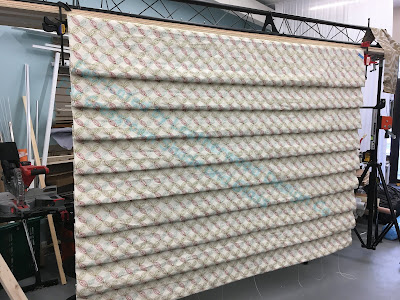Sometime workrooms get fabrics that turn out to be a knuckleball- for example, this embroidered fabric- and when it came in, I did need a little luck for it to work.
The stated repeat was 4", but the curve was- it turned out to be 3.5". So I had to change my game plan during the game.
Luckily, I had just finished teaching a Hobbled Shade Master Class at Workroom Tech, so I was well versed and fluent in hobbled shade improv!
Custom window treatments begin with a careful assessment by the workroom to determine a fabric's suitability for the project, and how it will be used. In order to plan this large hobbled shade for Crosstown Shade and Glass, I printed up images of this embroidered pattern:
I taped them together, and worked with the repeat until I had a layout I liked. Since the repeat was 4", I planned to make folds of 6", which meant that each fold had 1 1/2 rows of the flower motif, and every other fold would match. Fabric requirements were based on this fabrication plan.
This was a great plan, but then the knuckleball came over the plate. The repeat wasn't 4" at all- it was 3.5'.
That might not seem like a big deal, but, if I folded it according to the original layout, the folds would've been too small, with too little in the pleat. It would've looked cluttered and skimpy. I had to do it differently, but would there be enough fabric for a Plan B?
So instead I experimented with two repeats for each fold, and two full repeats in the pleat. The folds were so much better with extra fabric in the pleats. The luck I needed came in when I re-calculated the required yardage to suit the new specs, and I realized I'd have just enough!
You might wonder, how would this shade be compliant with the safety standards, since the loop created by the fabric + hobble tape would exceed the maximum 16.9". Well, I have a technique for that! My students learned it last month at Workroom Tech when they attended the Hobbled Shade Master Class that I taught. (I'll be teaching it again in August!)
Anyhow, from this point, fabrication went on as usual. Finally it was time to hang up the shade and check out the proportions and the finished length.
The original pattern repeat would have worked perfectly with the finished length. and the top fold would've been the same size as all the other folds. However, the new repeat resulted in a top fold that was too big.
It looked good raised all the way..........
But the homeowner planned to keep it halfway- and it looks awkward.
I taped up a piece of paper to show the designer how it would look with a topper that was smaller than the folds.
And that was the winner!
It looked good when fully raised....
And also partway up.
So this is a story with a lesson- build in a little luck for yourself when spec'ing out a job, in case you get a knuckleball. Don't assume that the stated fabric specs are accurate- round a bit up when calculating cut lengths, because an unforeseen circumstance might dictate a little more fabric.













No comments:
Post a Comment